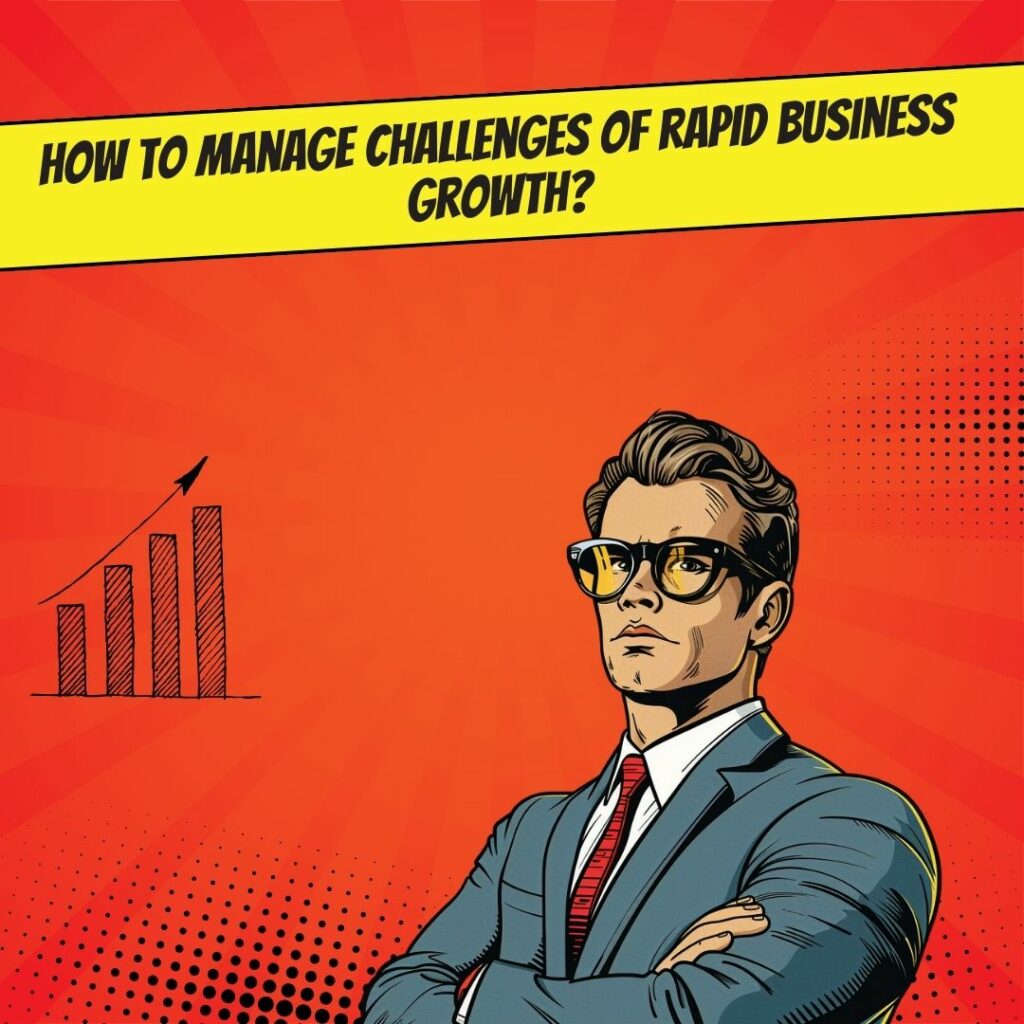Key Takeaways
✅ Define and Plan for Sustainable Growth: Sustainable growth isn't just a buzzword; it's a strategic necessity. Nearly 70% of fast-growing companies face the risk of business failure if they don't plan their growth carefully. Crafting a strategy that balances product innovation, market reach, and the capability to support expansion financially and operationally could be the difference between thriving and surviving. It's about setting realistic goals and building a robust framework to achieve them.
✅ Avoid Common Pitfalls: Rapid expansion can lead to significant oversights. A staggering 50% of business failures are attributed to a lack of understanding of financial management, including poor planning and oversight. Recognizing the pitfalls of staying too operational and not allocating enough time to strategic sales and marketing efforts is crucial. Learning to delegate effectively can free up essential resources to focus on growth opportunities and innovation.
✅ Pace Yourself and Innovate: Hasty expansion before stabilizing internal processes can spell disaster. Innovation isn’t merely for products or services; it should permeate through every aspect of your business, especially in adapting to market shifts and customer needs. Only 40% of new businesses survive past the five-year mark, partly due to a failure to adapt and innovate. Continually evolving and pacing your growth ensures your business remains competitive and sustainable in the long term.
 Introduction
Introduction
Did you know that while rapid business growth sounds promising, it comes with its share of hazards? Avoiding Pitfalls of Rapid Business Growth is not just about staying afloat but navigating through turbulent waters with foresight and agility. With the landscape of commerce ever-changing and the pressing demands of scalability, how do businesses manage to expand without tripping over their own success?
This article is your compass in the wilderness of expansion, offering a fresh perspective on sustainable success. Discover modern trends, innovative strategies, and the magic behind maximizing revenue, ROAS (Return on Ad Spend), and ROI (Return on Investment). Delve into a journey where actionable insights and groundbreaking information await, guiding you away from common mishaps towards enduring triumphs. Let's unlock the secrets to growing your business with foresight and finesse.
Top Statistics
| Statistic | Insight |
|---|---|
| Long-term top-quartile performance: Only 15% of top-growth quartile firms in 1985 sustained their performance for at least 30 years. | This showcases the rarity of sustaining rapid growth over decades, emphasizing the need for adaptive strategies and long-term planning. |
| Average growth rate comparison: The top quartile of firms experienced an 11.8% growth rate, significantly outpacing the lower three quartiles. | Indicates that high growth is not universal and highlights the extensive gap between the most and least successful firms. |
| Rapid growth and cash flow mistakes: Companies often stumble by letting monthly expenses exceed operating capital. | A crucial reminder of the importance of cash flow management and budgeting to avoid the pitfalls of unchecked expansion. |
| Importance of forecasting cash requirements: Analyzing cash inflow and outflow is essential to determine future cash needs. | Underlines the key role that financial forecasting plays in maintaining stability during periods of heavy growth. |
| Ensuring sustainable growth: Critical analysis of sales, expenses, and assets is crucial for long-term success. | Points out that sustainable growth is not just about boosting sales but also about smart management of all resources. |
Lack of a Business-Growth Strategy
Rapid business growth is a dream for many, but without a strategy, it can quickly become a nightmare. Imagine running faster and faster without knowing where you’re going—that's what growth without a plan feels like. A comprehensive business-growth strategy is essential. It ensures that as a business expands, it keeps up with the increasing demands in resources, both financial and human, and continues to deliver quality service to its customers. A clear, well-defined strategy helps a business navigate growth without losing sight of its goals or compromising on its values.
Minimal Understanding of the Financial Impact
When sales start climbing, it’s easy to get caught up in the excitement and forget about the underlying costs. But here’s the catch: growing businesses face growing expenses. This misconception—that more sales directly mean more profit—is a trap many fall into. Business owners need a solid grasp on their financial reality, including costs associated with ramping up production or expanding the team. Keeping a close eye on financial metrics ensures that growth is not only impressive on paper but also sustainable and profitable.
Inefficient Leadership and Staff
Growth doesn't just test a product; it tests people. The leadership team and staff play a pivotal role in scaling a company. Quick decision-making, the agility to adapt, and strong leadership qualities become indispensable. Bringing new people on board? They need to hit the ground running. This makes an effective onboarding process vital. Investing in training and development for new and existing staff ensures that the team not only grows in size but also in capability.
Lost Long-Term Focus
It’s easy to get caught up in the now when everything’s moving at lightning speed. But what about tomorrow? Retaining a long-term focus is critical. Businesses need to carve out time for strategic planning, ensuring they’re not just reactive but proactive. Thinking about the future—from succession planning to talent retention—ensures that a business doesn’t just grow rapidly but also sustainably and strategically. A long-term lens helps keep the bigger picture in focus, despite the whirlwind of day-to-day challenges.
Employee Burnout and Interpersonal Tensions
With great growth comes great pressure. Teams often find themselves stretched thin, which can lead to burnout and strain among colleagues. Recognizing this risk is the first step; actively managing it is the next. Implementing stress management practices, promoting emotional intelligence, and encouraging open communication can help maintain a healthy work environment. A supportive culture not only aids in managing the current growth but also positions a company better for future expansions.
Managing Cash Flow and Operational Efficiency
Cash is king, especially in periods of rapid growth. Effective cash flow management is the lifeline of a growing business. It’s about more than just keeping the lights on—it’s about strategic investment and cost management to ensure long-term success. Analyzing cash inflows and outflows, maintaining tight control over receivables and payables, and identifying opportunities for cost savings are all critical for sustaining growth. By focusing on operational efficiency, businesses can not only survive rapid growth phases but thrive through them.
Do you see your business in any of these scenarios? Each of these areas holds the key to not just surviving rapid growth but making it a stepping stone for sustained success. With the right strategies and practices in place, the challenges of growth can be met head-on, ensuring a brighter future for your business.
AI Marketing Engineers Recommendation
Recommendation 1: Harness the Power of Automation for Customer Service: With 67% of customers preferring self-service over speaking to a company representative, integrating chatbots and automated service solutions can meet customer expectations and reduce the strain on your service team as your business grows. By implementing these automated systems, you can ensure that customer inquiries are handled promptly and efficiently, even during peak times. This not only improves customer satisfaction but also allows your human representatives to focus on more complex issues that require a personal touch. In the long run, automation can lead to cost savings, enhanced customer loyalty, and a scalable service model that grows with your business.
Recommendation 2: Regularly Analyze and Adjust Your Marketing Tactics: The digital marketing landscape is constantly evolving, with social media algorithms and search engine policies changing frequently. Businesses that stay informed and are ready to pivot their strategies based on current trends can maintain their growth without being left behind. Regularly analyzing your marketing tactics using real-time data helps you stay ahead of the curve. By understanding what works and what doesn’t, you can adjust your campaigns to better engage your audience, optimize your ad spend, and drive more effective results. This proactive approach ensures that your marketing efforts are always aligned with the latest industry standards and consumer preferences.
Recommendation 3: Implement a Robust Analytics Tool: Understanding where your traffic comes from, which pages perform best, and where potential customers drop off is crucial for making informed decisions that steer your growth in the right direction. Implementing a robust analytics tool like Google Analytics or a more advanced AI-based analytics platform can provide these insights. By analyzing this data, you can fine-tune your user experience, improve conversion rates, and allocate your marketing budget more effectively. These tools offer a comprehensive view of your website’s performance, enabling you to identify opportunities for improvement and make data-driven decisions that enhance your overall business strategy.
Relevant Links
- Harnessing AI for Unstoppable Marketing Success
- Crafting Campaign Goals like a Pro
- Unlocking Market Penetration Secrets
- Maximizing Ad Spend Efficiency: Insider Tips
Conclusion
Growth is the drumbeat to which every business marches, yet rapid business growth brings its own set of challenges – pitfalls that can undermine the efforts and aspirations of even the most robust businesses. Reflecting on the wisdom shared in the article, it's clear that avoiding these pitfalls isn't merely about survival; it's about thriving sustainably. Among the most critical takeaways is the absolute necessity of a well-defined growth strategy. This blueprint is what allows a business to align its operational capabilities with the increased demand, sidestepping the chaos that unchecked growth can spawn.
Equally crucial is the understanding that more sales don't always mean more profit. A sharp eye on the financial implications of growth – understanding the nuances of cash flow, investment needs, and the cost of expansion – is what separates businesses that grow from those that grow wisely. Moreover, the backbone of any growing business is its people. Leadership that can adapt and a workforce that can expand without diluting the quality are non-negotiable for success.
Yet, what often gets lost in the fast pace is the future. A long-term focus is the anchor that prevents businesses from drifting away in the currents of immediate success; it ensures that growth today doesn't come at the expense of tomorrow's opportunities. And let's not forget the human element – managing growth compassionately means acknowledging the risk of employee burnout and interpersonal tensions, and actively working towards a healthy, motivated workforce.
In sum, navigating the exhilarating yet perilous journey of rapid growth requires a careful balancing act – strategy, financial wisdom, effective leadership, a focus on the future, and a commitment to employee well-being. These are the pillars that support not just growth, but sustainable and meaningful expansion. So, as we step forward, let us not just grow for the sake of growth but strive to grow better. This exploration into the pitfalls of rapid business expansion is more than a cautionary tale; it is a playbook for those ambitious enough to scale new heights responsibly. Standing on the precipice of growth, the question isn't whether to grow, but how to grow wisely and well. How will you write your next chapter?
FAQs
Question 1: What are the common pitfalls of rapid business growth?
Answer: Common pitfalls include getting distracted by new ideas, chasing every new opportunity, making the wrong hires, spreading yourself too thin, issues with customer service, lack of a business-growth strategy, minimal understanding of the financial impact of rapid growth, being ill-equipped to fulfill orders on time, offering too many products to too many customers, inefficient leadership and staff, and poor leadership styles.
Question 2: Why is it important to plan for rapid growth?
Answer: Planning for rapid growth helps businesses avoid common pitfalls, maintain their identity and high standards of customer service, and ensure long-term success. It involves considering the financial and human-resources requirements, as well as adapting day-to-day operations to meet future needs.
Question 3: What are the key elements of a business-growth strategy?
Answer: A business-growth strategy should include planning for financial and human-resources requirements, adapting day-to-day operations, and ensuring effective financial monitoring systems. It should also consider the skills and leadership styles of the management team and the onboarding process for new recruits.
Question 4: How can businesses manage the financial impact of rapid growth?
Answer: Businesses can manage the financial impact by implementing effective financial-monitoring systems that track costs such as materials, machinery, staff, marketing, and overheads. This helps ensure that working capital does not run ahead of demands.
Question 5: What are the signs of business failure during rapid growth?
Answer: Signs of business failure include a sudden increase in customer complaints, inability to fulfill orders on time, and inefficient leadership and staff. Businesses should be aware of these signs and take proactive measures to avoid them.
Question 6: How can businesses maintain customer service during rapid growth?
Answer: Businesses can maintain customer service by ensuring they can fulfill orders on time, listening to and responding to customer complaints, and adapting their operations to meet growing demands.
Question 7: How can businesses avoid spreading themselves too thin during rapid growth?
Answer: Businesses can avoid spreading themselves too thin by prioritizing tasks, focusing on key areas, and delegating responsibilities effectively. They should also be aware of warning signs such as staff burnout and process breakdowns.
Question 8: What are the benefits of engaging with a business growth consultant?
Answer: Engaging with a business growth consultant can help businesses develop strategies that make sense in the real world, manage rapid change, and maintain a clear long-term focus. Consultants can also provide guidance on stress management and leadership development.
Question 9: How can businesses prevent employee burnout during rapid growth?
Answer: Businesses can prevent employee burnout by engaging with a business growth consultant, implementing stress management techniques, and ensuring that employees have the skills to cope with rapid expansion. They should also prioritize employee well-being and maintain open communication.
Academic References
- Churchill, N. C., & Lewis, V. L. (1983). The Five Stages of Small-Business Growth. Harvard Business Review, 61(3), 30-50. This seminal study delves into the development stages of small businesses, underlining the unique managerial challenges and strategies pertinent at different phases of growth. It offers a comprehensive framework that aids entrepreneurs in understanding and navigating the complex landscape of business expansion.
- Mason, C., & Stark, M. (2004). The Seven Pitfalls of Business Failure and How to Avoid Them. Entrepreneurship Theory and Practice, 28(4), 379-398. Through an analysis of the interplay between an entrepreneur's background (including intelligence, previous self-employment experience, and education) and their business intentions, this research provides a deep dive into the critical factors that influence the success or failure of a business. It highlights the importance of understanding these elements to build a resilient and thriving business.
- Hamilton, R. T. (2012). Growing Too Fast: The Dangers of Overtrading to Entrepreneurs. Journal of Small Business Management, 50(3), 465-488. This literature review brings to light the concept of overtrading, a critical issue for entrepreneurs leading rapidly growing enterprises. It presents overtrading as a crucial factor in assessing the potential for business failure, underlining the risks inherent in unchecked growth. The paper serves as a cautionary tale, offering strategies to mitigate these risks and sustain healthy business development.









